Georgia - 2024 Election Compendium
Topic: 2024 Election Analysis
Georgia 2024 Presidential Election Review
Author’s Note: All 2024 Election Reviews can be found here.
Outcome
Trump +2.2% (+115,100)
Trump +4.1% (+204,998)
Preface
For most of this cycle, I considered Georgia a key ingredient for a Trump election win, and my assumption was that if he couldn’t get over the hump there, he would probably lack the steam to take the electoral votes of Pennsylvania, Michigan, or Wisconsin. As it stands today, Trump would have won the election with North Carolina plus Arizona plus Nevada plus Pennsylvania, suggesting Georgia may be departing from previously established predictive traits as the Atlanta metro grows and wrecks statewide Republican political dreams, while the GOP benefits from crossover Hispanics in the Southwest and the overwhelming support of the white working-class in the Industrial Midwest.
Thanks to the massive distribution of mail-in ballots in the 2020 race, Biden’s 2020 Georgia victory will be forever tainted, all the way down to awkward moments like the one in which Secretary of State Brad Raffensperger hit the media circuit on November 4 and bragged about the record “4.7 million” turnout, just a couple weeks before the state certified almost exactly 5 million ballots.
Georgia does not register its voters by party. Shortly before the election, in an effort to discern likely shifts, I discovered the Duval County bellwether, which came online two decades ago. That Florida county, which contains metro Jacksonville, has served as a perfect mirror of Georgia since 2004, constantly sitting just left of the Peach State and swinging the same way, and its voter registration figures suggested it (Duval) was due for a solid move rightward:
Georgia moving rightward, along with Duval, from an 11,779 ballot Republican deficit in 2020 would mean certain victory for Trump, so I made my prediction that Trump would carry Duval, and with it, flip Georgia. I arrived at a 4.1% margin prediction in Georgia by splitting the difference between the average of my pessimistic model and the Duval model, and again splitting the difference between that average and the Duval model, which I considered most likely.
Analysis
· Duval County, Florida, flipped to Donald Trump (+1.4%), and remained a perfect mirror of Georgia for the sixth straight presidential election. Duval shifted 5.2% to the right, with Georgia moving 2.4% right from its 2020 result, which appears artificially shortened based on what I will reveal throughout this report.
· 136 of 159 counties (85.5%) shifted more Republican from 2020, meaning those 136 were either won by a greater percentage margin, or lost by less of one. Notably, the musical chairs game in the suburban Atlanta counties continued, with black voters moving out of the urban core of Cobb, Gwinnett, Clayton, Fulton, and DeKalb Counties making the collar counties bluer or less red, and the major core counties drifting slightly rightward as a result. Many of these shifts are incremental or barely measurable, particularly in small counties. Republican and Democrat shifts by county shown below:
· I accurately predicted Baldwin and Washington Counties would flip to Trump, but did not forecast Jefferson County also doing so.
· The “Gang of Eight” Metro Atlanta Counties, those I identified with substantial voter registration increases stemming from Automatic Voter Registration’s implementation, gave margin shifts like this in terms of raw votes:
· Incredibly, George W. Bush won these eight counties collectively 20 years ago, back when Cobb, Gwinnett, and Henry Counties were heavily Republican and things weren’t so bad in core Atlanta. Fortunately, Trump stopped the bleeding here and wound up improving by 17,056 in margin, enough to evaporate Biden’s 2020 margin statewide. Cherokee and Forsyth Counties, although shifting slightly left in percentage margin, came up strong for Trump, and sagging black voter turnout in core Atlanta cost more margin for Harris. Only Henry County was a real boon for her, moving heavily Democrat because of continued demographic shifting.
· Referencing the above map – despite getting destroyed in the Deep South, falling below Clinton in Louisiana and Mississippi, and below Biden in South Carolina, Tennessee, Alabama, and Florida, while gaining only marginally in North Carolina, Harris gained 74,384 ballots over Biden’s 2020 total, which was already dubiously high in that it vaulted him over the highest single cycle Republican vote gain in 16 years, in a state that hadn’t backed a Democrat since 1992 (and even then, it was because H. Ross Perot cost Bush 41 the state that year).
· The large central portion of Georgia resembles the rest of the Deep South in that the rural and minor urban area black vote is extremely weak, pushing Harris’s vote count below Biden’s in the large majority of central Georgia’s counties, and even below Clinton’s 2016 totals in 16 counties. Two areas stand out for aberrant Democrat growth – coastal Georgia, which is largely conservative outside of Savannah and Chatham County, and nearly the entirety of northern Georgia, which includes the Atlanta metro. The areas outside of the immediate urban and suburban area are among the most conservative in the country when considering northern Georgia alone, and none of them failed to produce fewer Democrat votes than they did in 2020.
The following map, zoomed out from Georgia’s, will show just how curious the pattern of Harris gains is:
· The contrast map above includes the four states I included in the Deep South (Louisiana, Mississippi, Alabama, and South Carolina), Tennessee, which I included in Appalachia, six counties of far western North Carolina, and 37 counties in northern Florida, of which many are considered Deep South culturally.
· Apparently, something magical happens when crossing the imaginary line separating northern Georgia from northern Alabama. Consider:
· The only county listed above between the two states with any significant population growth is Carroll County, which had just 7.8% population growth per the latest U.S. Census over the previous decade. These counties, as is unsurprising given their locations geographically and Trump margins, are overwhelmingly white, and almost all Democrat votes that are there, given that this is the Deep South, are from black voters, whose turnout tanked throughout the heart of the state south of metro Atlanta. To fail to look at these differences without scrutiny is to believe that while the black vote didn’t turn up in the Deep South, enough to plunge many counties below Clinton 2016 levels, white voters took up the slack for the Democrats in some of the reddest counties in America in the same year the GOP nominee won overwhelming and, in many cases, record margins.
· The Georgia coast is another area of concern for me, especially given that Harris lagged Biden in Duval County, Florida, despite its growth, and failed to gain votes in three of six coastal South Carolina counties, including Charleston County. She gained in all six counties bordering the Atlantic Ocean in Georgia. The vote growth fades shortly after the map turns inland.
Quality Checks
Statewide Presidential Ballot Count
· 2004 3,304,481
· 2008 3,932,158 (+627,677, +16.0%)
· 2012 3,908,369 (-23,789, -0.6%)
· 2016 4,146,825 (+238,456, +6.1%)
· 2020 4,999,960 (+853,135, +20.6%)
· 2024 5,250,047 (+250,087, +5.0%)
Georgia’s 2024 ballot jump is only the third highest in the past five jumps, which doesn’t jump off the page; however, the two-cycle increase to 5.25 million ballots is leaps and bounds above the 2008 to 2016 jump, which was the period in which the Obama sugar high waned and Trump won the state without even needing to campaign in it. The total amount of votes based on reported population (in which Georgia failed to receive a new electoral vote for the first time since the 1980s) is still far higher than anyone would have forecasted for 2024 a decade ago.
Key Counties
Fulton County
One saving grace for Trump is that Fulton County’s vote was somewhat whiter than it was in 2020, and with far fewer mail-in ballots in circulation. The county tried to cheat the weekend before the election by opening its offices to collect mail-in ballots (along with other Democrat strongholds Clarke, Cobb, DeKalb, Fulton, and Chatham Counties), but didn’t get far enough with that to tip the state this time around. There are white, affluent voters crammed into the oddly shaped end of northern Fulton County, but they’ve drifted substantially left since the days of Mitt Romney. This is Georgia’s largest voting county and, by default, the most critical for ensuring statewide GOP success as far as election reforms and voter roll purges go.
DeKalb County
DeKalb, the eastern half of core Atlanta, is majority black and steadily serves as a kick in the ribs for statewide elections. Despite the population growth there, lower black turnout and more controls over mail-in ballots resulted in 8,532 fewer Harris ballots than Biden ballots, and a slight Trump increase resulted in a shift of roughly 3 points right of the 2020 result. The net shift in raw vote margin was 12,777, or 998 more margin needed to undo margin of 11,779 in favor of Biden in 2020’s certified results. As the Latino population grows, the county will likely begin to shift rightward enough to avoid total obliteration in line with the 2020 outcome, led largely by the county’s corruption that year.
Gwinnett County
Gwinnett County, an original suburban county of Atlanta before its population explosion, is a minority-majority county that backed every Republican presidential nominee from 1980 through 2012 before flipping to Hillary Clinton in 2016. The Democrat margin exploded there in 2020 to 18.2% thanks to substantial ballot harvesting, registration corruption, and altered voting rules, but moved 1.7% back to the right this year. Latinos make up nearly a quarter of the population and will likely surpass blacks as a share of population by the next census. As such, the county will likely become more competitive if strong election reforms are pursued.
Cobb County
Atlanta’s original suburb to the west was also a Republican stronghold from 1980 through 2012 and is slightly more competitive than Gwinnett for the time being. It is the only county among these four profiled that shifted left, although the move was under a half-point. The county, like Gwinnett, is also a minority-majority county, but contains a significant number of college whites, making it a politically difficult county to make inroads in now that the GOP has trended toward populism. The boom in housing developments and its confluence with Automatic Voter Registration creates ample opportunity for ballot harvesting and mail-in balloting corruption.
Opportunities for Election Manipulation
Familiarize yourself with the grading criteria for my election ratings. Here is how Georgia rates with regard to the most common election demerits, and its own unique traits:
· Voter ID – Georgia has strict in-person Photo ID laws.
· Same Day Registration – Not authorized in Georgia.
· Ballot Harvesting – It is not authorized for non-family members to turn in ballots; not heavily penalized, and a practice shown to occur substantially throughout the Atlanta metro.
· Automatic Voter Registration – Georgia is flooded with fraudulent registrations thanks to their 2016 implementation of Automatic Voter Registration, which was the primary reason President Trump was unable to secure the Peach State’s electoral votes in 2020.
· Unique Urban Corruption – As evidenced by the attempt to circumvent state law on ballot collection, the core Atlanta Counties of Cobb, Gwinnett, Fulton, and DeKalb are uniquely toxic and pose as much of a threat to statewide election integrity efforts as Maricopa does to Arizona, or Clark does to Nevada.
The Road Ahead
For the second election in a row, Georgia came in left of North Carolina. Fortunately, Trump’s win in the Peach State expedited the calling of his overall national victory, but Georgia has now clearly replaced Florida as the race to watch in the southeast. Trump’s win, especially given that the GOP is nearly maxed out in rural Georgia, is uncomfortably narrow with the growth of metro Atlanta continuing uninterrupted, and demographic shifting created a blue streak in the northern half of the state.
I am confident that, thanks to Automatic Voter Registration, the potential for widespread cheating remains a constant threat in the Peach State. Some of Harris’s vote gains are organic and owed to black populations shifting from county to county, but those gains also met and surpassed Biden’s laughably high 2020 totals, which practically no one believes are legitimate. Mail-balloting was substantially down, but the state still had nearly 300,000 mail ballots in circulation. It is likely that harvesting rings are responsible for collecting them, and the most obvious locations for these activities are along the Atlantic Coast and throughout the Atlanta metro, most likely in low-income areas, apartments, and housing projects. Georgia also swears by their unique electronic elections infrastructure, which given the corruption in the voter roll likely possesses the ability to alter results.
Georgia, especially with North Carolina trending positively at the presidential level, can potentially be replaced with looming battleground states like New Jersey or Virginia, but neither are poised to flip anytime soon. The most important thing that can happen to Georgia’s elections is to move quickly to abolish Automatic Voter Registration and purge the roll in a way that has been practiced in Florida, Texas, or Iowa. Voter engagement with black men in core Atlanta, as well as the steadily growing Latino population, will be the only thing that keeps Georgia in the GOP column moving forward and stopping it from becoming a clone of Virginia - a massively red state dominated by a single geographically small urban area.
Final Grade and Closing Commentary
The Top 5 Election Integrity Targets in Georgia are (in no order):
· Fulton County
· DeKalb County
· Cobb County
· Gwinnett County
· Clayton County
Most Suspect Outcome
· Statewide Presidential Margin – should be considerably higher than 2.2% based on likelihood of ballot stuffing in highlighted areas intended to offset atrophy of rural and minor urban black vote.
Georgia receives a Grade of 3 – Elevated Concern – based on its demerits, known troubles, indication of concentrated manipulation in 2024, including the actions of its key urban counties in seeking to defy state law, and its status as a critical battleground state.
Seth Keshel, MBA, is a former Army Captain of Military Intelligence and Afghanistan veteran. His analytical method of election forecasting and analytics is known worldwide, and he has been commended by President Donald J. Trump for his work in the field.




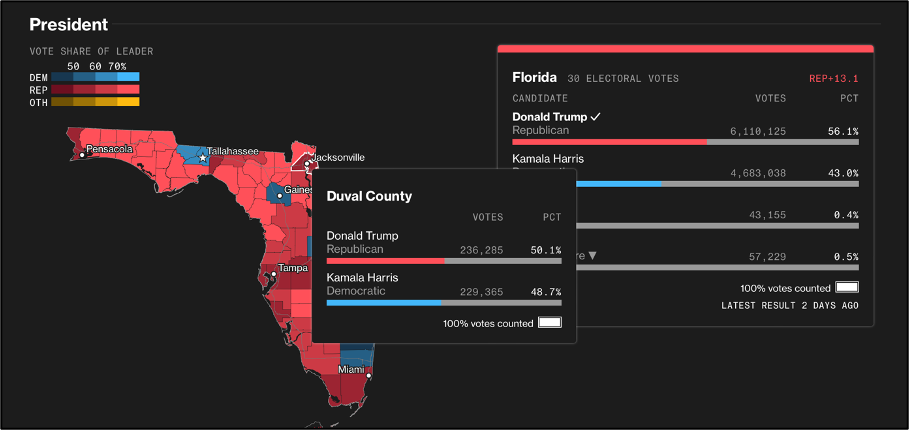
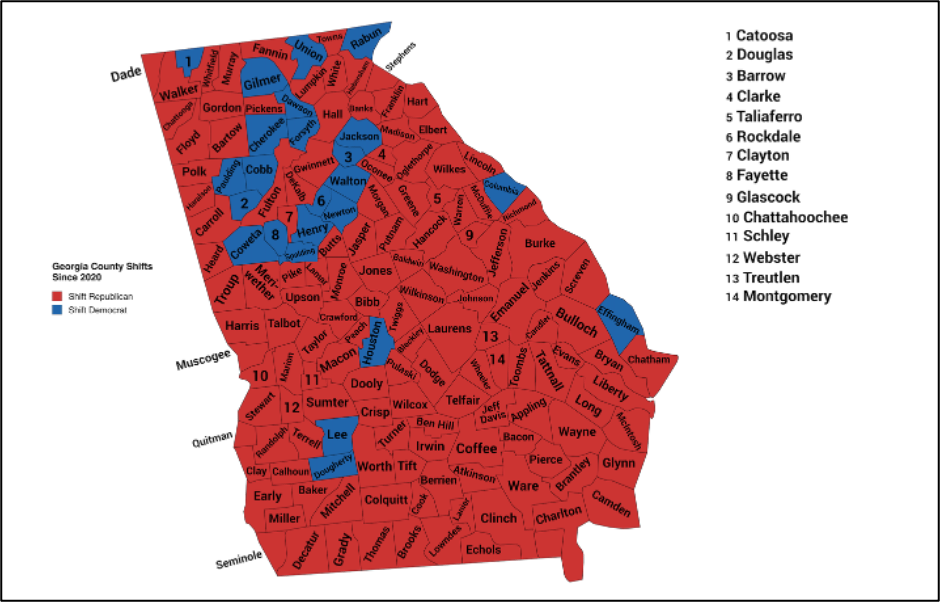
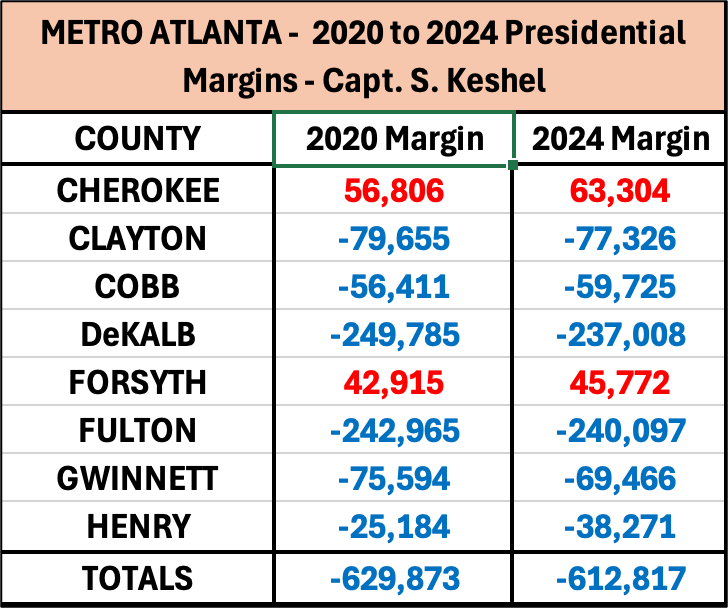
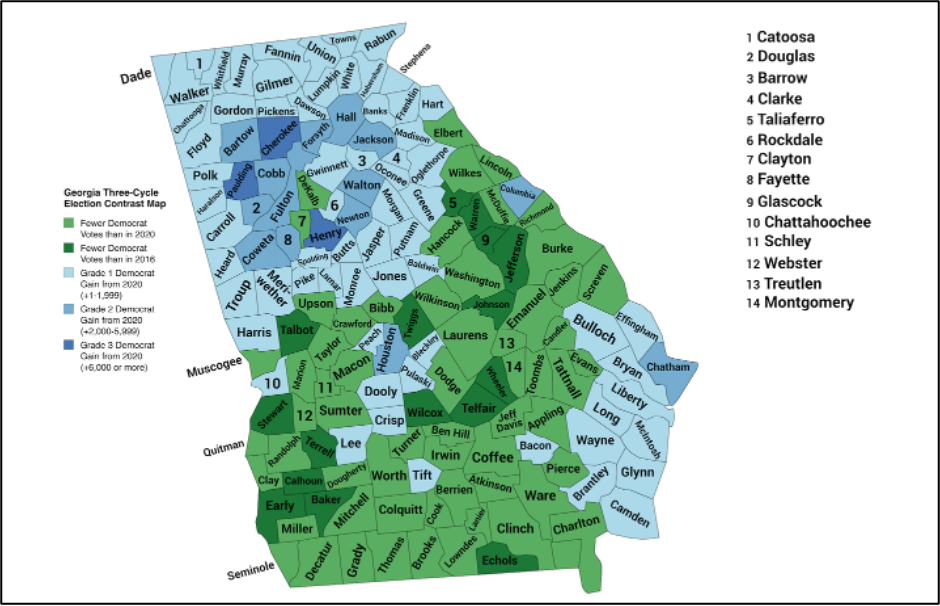
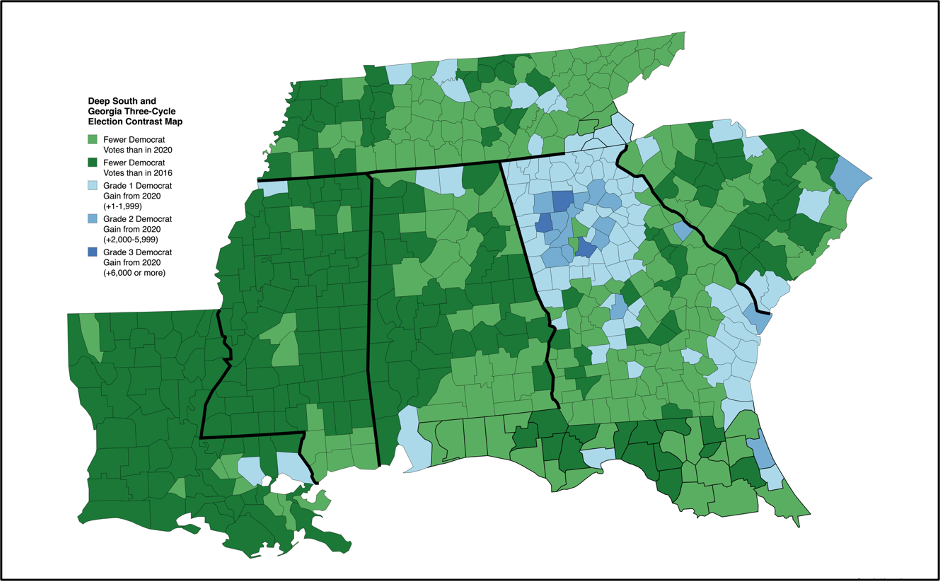

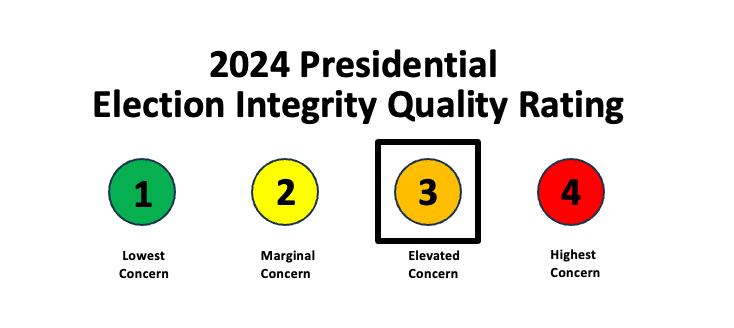
Kudos. Great job!